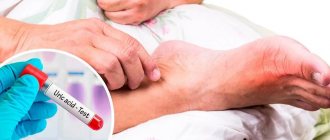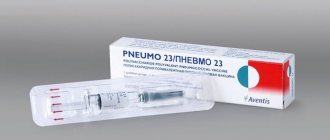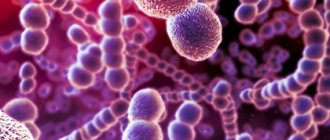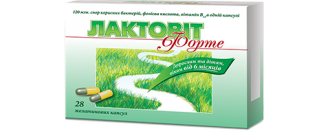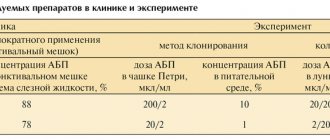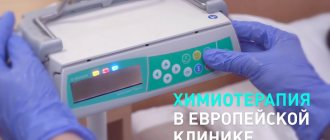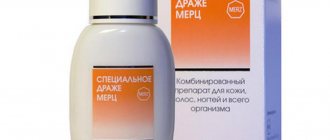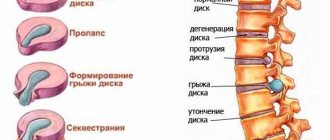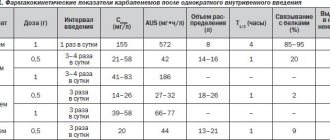Lipoic acid 25 mg
Lipoic acid
Registration number and date: РN 001574/01 dated 05/10/2007
Trade name of the drug: Lipoic acid
International nonproprietary name: thioctic acid Dosage form: film-coated tablets
Compound:
Active substance:
Lipoic acid (thioctic acid) -12 mg and 25 mg
Excipients: sugar (sucrose), glucose (dextrose), potato starch, calcium stearate 1-water (calcium stearate monohydrate), stearic acid, talc (magnesium hydrosilicate).
Excipients of the shell: aerosil (colloidal silicon dioxide), beeswax, titanium dioxide, basic magnesium carbonate (magnesium hydroxycarbonate), vaseline oil, low molecular weight medical polyvinylpyrrolidone (povidone), sugar (sucrose), talc (magnesium hydrosilicate), quinoline yellow dye E -104.
Description
Yellow or greenish-yellow film-coated tablets.
The cross section shows two layers.
Pharmacotherapeutic group: metabolic agent.
ATX code : [A05BA].
pharmachologic effect
Lipoic acid is a coenzyme involved in the oxidative decarboxylation of pyruvic acid and alpha-keto acids and plays an important role in the body's energy balance. By the nature of its biochemical action, thioctic acid is similar to B vitamins. It participates in the regulation of lipid and carbohydrate metabolism, has a lipotropic effect, affects cholesterol metabolism, improves liver function, and has a detoxification effect in case of poisoning with heavy metal salts and other intoxications.
Indications for use
Fatty liver, liver cirrhosis, chronic hepatitis, hepatitis A, intoxication (including salts of heavy metals, toadstool), hyperlipidemia.
Contraindications
Hypersensitivity, lactation period, children's age (up to 6 years).
With caution - pregnancy
Directions for use and doses
Inside after meals. Adults - 50 mg 3-4 times a day.
Children over 6 years old - 12-24 mg 2-3 times a day.
The duration of treatment is 20-30 days. If necessary, as prescribed by a doctor, a second course of treatment is carried out after 1 month.
Side effect
Dyspepsia (including nausea, heartburn, vomiting, diarrhea, abdominal pain), allergic reactions (including urticaria, skin rash, itching and systemic allergic reactions up to anaphylactic shock), hypoglycemia.
Interaction with other drugs
Strengthens the anti-inflammatory effect of glucocorticosteroids. Reduces the effectiveness of cisplatin. Enhances the effect of insulin and oral hypoglycemic agents. Binds metals, so should not be taken simultaneously with drugs containing metal ions (iron, calcium magnesium); the interval between doses should be at least 2 hours. Ethanol and its metabolites weaken the effect of lipoic acid.
special instructions
During the treatment period, regular monitoring of glucose concentrations (especially at the beginning of therapy) in patients with diabetes mellitus is necessary; you should refrain from drinking alcohol.
Release form
Film-coated tablets 12 mg and 25 mg.
10 tablets per blister pack.
50, 100 tablets in glass jars or polymer jars.
Each jar or 5 blister packs along with instructions for use are placed in a pack.
Conditions for dispensing from pharmacies
On prescription.
Storage conditions:
In a dry place, protected from light, at a temperature not exceeding 25°C.
Best before date:
3 years. Do not use after the expiration date stated on the package.
Units:
pack
pharmachologic effect
The active component is an endogenous antioxidant that is capable of binding aggressive free radicals. Alpha lipoic acid acts as a coenzyme in the transformation of substances that have pronounced antioxidant effects.
Such substances are able to exhibit protective, protective functions in relation to cells, protecting them from the aggressive effects of reactive radicals that are formed during intermediate metabolism, or at the time of the breakdown of foreign exogenous substances (including heavy metals).
The active substance is involved in the mitochondrial metabolism of substances inside the cell. By stimulating the utilization of glucose, thioctic acid is capable of synergizing with insulin . In patients with diabetes mellitus, changes in the level of pyruvic acid concentration in the blood are recorded.
According to the mechanism and nature of the biochemical effect, the active substance is similar to B vitamins . The active substance has a lipotropic effect, which manifests itself in accelerating the utilization processes of lipids in the hepatic system. Lipoic acid can stimulate the transfer of fatty acids from the liver system to various tissues in the body.
The nature of the drug is a detoxification effect when salts of heavy metals enter the body and in case of other poisoning. Thioctic acid changes cholesterol metabolism, improves the general and functional condition of the liver.
Lipoic acid, instructions for use (Method and dosage)
300-600 mg of thioctic acid is administered intravenously daily, which corresponds to 1-2 ampoules of 10 ml and 1 ampoule of 20 ml of concentration 3%. The duration of therapy is 2-4 weeks, after which treatment is continued in tablet form at a daily dose of 300-600 mg.
Instructions for use of Lipoic acid tablets
Orally 30 minutes before meals. Tablets should not be broken or chewed. Daily dose: 1 tablet 1 time per day (300-600 mg). The therapeutic effect is achieved by taking 600 mg per day. In the future, the dose can be halved.
For diseases of the liver system, tablets are prescribed: up to 4 times a day, 50 mg for a month. A repeat course can be carried out after 1 month.
Treatment of diabetic neuropathy and alcoholic polyneuropathy: begin with intravenous injections with the transition to a tablet form of 600 mg per day.
Indications for use of Lipoic acid
The medication is widely used in the treatment of liver pathology, the nervous system, alcoholism and intoxication, diabetes mellitus, and to alleviate the course of cancer.
Main indications:
- chronic hepatitis in the active phase;
- chronic pancreatitis due to alcoholism;
- chronic cholecystopancreatitis ;
- acute liver failure;
- intoxication with heavy metals, sleeping pills, carbon, carbon tetrachloride, mushrooms;
- viral hepatitis with increasing jaundice ;
- hepatic cirrhosis;
- diabetic polyneuritis;
- alcoholic polyneuropathy;
- poisoning with toadstool;
- fatty liver degeneration;
- dyslipidemia;
- coronary atherosclerosis .
During a course of treatment with Prednisolone, the medication acts as a corrector and synergist to prevent the development of “withdrawal syndrome” and gradually reduce the dose of glucocorticosteroid.
Lipoic acid for weight loss
The mechanism of action of the active substance allows the medication to be used to lose excess weight. The effect is more pronounced when simultaneously actively playing sports. Lipoic acid can trigger the fat burning mechanism, but it is not possible to burn absolutely all excess fat on its own, so intense physical activity is required.
Muscle tissue “attracts” nutrients during training, and thioctic acid can increase endurance, enhance fat burning and increase the overall effectiveness of physical activity. Simultaneous adherence to the diet allows you to achieve the greatest results.
Lipoic acid dosage for weight loss
Usually 50 mg of medication is sufficient. The minimum threshold is 25 mg. The most effective time to take the drug to achieve maximum results in the fight against excess weight:
- before or immediately after breakfast;
- at the last daily meal;
- after training, physical activity.
Reviews
The drug works well when following a diet and at the same time an active combination of exercises in the gym. On thematic forums, users discover a little secret: the drug works better when taking carbohydrate foods (semolina or buckwheat porridge, dates, honey, pasta, rice, peas, beans, bread products).
Lipoic acid in bodybuilding
Quite often in bodybuilding, thioctic acid is combined with levocarnitine ( Carnitine , L-carnitine ). This amino acid is a relative of B vitamins and can activate fat metabolism. Levocarnitine releases fat from cells, stimulating energy expenditure.
Interaction
The medication can enhance the effects of glucocorticosteroid drugs. Suppression of the activity of Cisplatin . The drug enhances the effect of hypoglycemic agents (oral forms) and insulin.
It is not recommended to use with medications that contain metal ions (calcium, magnesium, iron) due to the ability of lipoic acid to bind metals.
If there is an urgent need to use drugs, it is recommended to maintain a certain time interval (at least 2 hours). Ethanol metabolites and ethanol itself weaken the effect of thioctic acid.
Side effects
- diarrhea syndrome;
- epigastric pain;
- nausea;
- anaphylactic reactions;
- skin rashes;
- vomit;
- convulsions;
- increased intracranial pressure ;
- disorders of glucose metabolism ( hypoglycemia );
- migraine -type headache ;
- hives;
- itching;
- tendency to bleeding (with functional disorders of platelets );
- pinpoint hemorrhages;
- diplopia;
- difficulty breathing.
Similar drugs
Level 4 ATX code matches:
Verona
Phibs
Gastrikumel
Fitogastrol
Thyroidea Compositum
Berlition
Thiolepta
Gastric collection
Espa-Lipon
Brewer's yeast
Rosehip syrup
Octolipen
Thioctacid
Thiogamma
Figurin
Preparations containing thioctic acid:
- Berlition
- Thiolepta
- Octolipen
- Thioctacid
- Tiogram
- Alfa-Lipon
- Espa-Lipon
special instructions
The main metabolic pathways are oxidation and conjugation.
Benefits and harms
Lipoic acid is a natural antioxidant and vitamin. It helps normalize and accelerate metabolic processes, stimulates the pancreas, removes toxins from the body, lowers blood sugar levels, improves visual perception, has a beneficial effect on heart function, lowers cholesterol , and helps normalize blood pressure.
With the use of Lipoic acid, there is a decrease in the severity of negative reactions that occur after chemotherapy in cancer patients.
The drug has a beneficial effect on the condition of nerve endings damaged as a result of diabetes. Rarely do negative reactions occur during the use of the medication.
Lipoic acid reviews
The medication is well tolerated and has proven itself as an effective drug for intoxication, poisoning, and diseases of the liver system.
Reviews of Lipoic acid for weight loss
There are a variety of reviews. Some felt absolutely no effect, maintaining their weight despite regularly taking the medication. Some users note that taking Lipoic acid in combination with intense cardio exercise and following a certain diet can significantly reduce weight without harming their health.
Patients suffering from diabetes mellitus note that the medication can reduce the severity of negative reactions of hypoglycemic drugs (in some cases it was possible to reduce the dosage) and improve overall well-being.
Lipoic acid price, where to buy
Most often, the drug is purchased for weight loss. You can buy Lipoic acid in a pharmacy in Russia for about 100 rubles.
The price of Lipoic acid in Ukraine is about 100 UAH.
- Online pharmacies in RussiaRussia
- Online pharmacies in UkraineUkraine
ZdravCity
- Lipoic acid caps.
Doctor's Best/Doctor Best 230 mg 60 pcs Doctor's Best 3812 rub. order
Pharmacy Dialogue
- Lipoic acid Vitamir tablets No. 30 Square C
85 rub. order
show more
